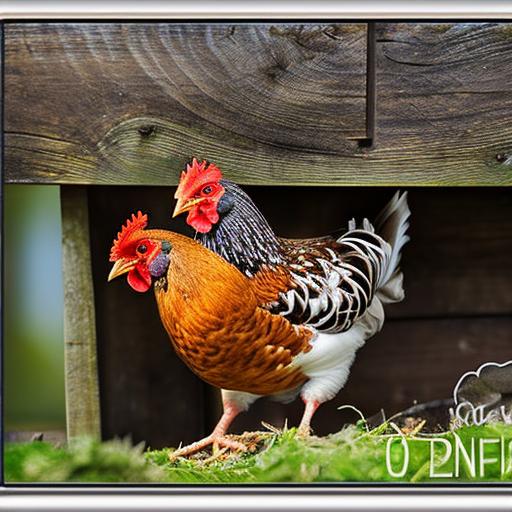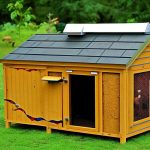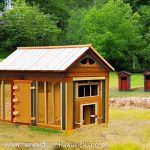Raising chickens has become increasingly popular in recent years, and for good reason. Not only do chickens provide a sustainable source of food, but they also offer numerous benefits for the whole family. Converting your shed into a chicken coop is a cost-effective and practical way to start your own flock. It allows you to utilize existing space and resources while providing a safe and comfortable environment for your chickens.
One of the main benefits of raising chickens is the cost-effective and sustainable food source they provide. By converting your shed into a chicken coop, you can have a constant supply of fresh eggs and meat right in your backyard. This can significantly reduce your grocery bills and ensure that you have access to high-quality, organic food. Additionally, chickens are excellent at recycling kitchen scraps and garden waste, turning them into nutrient-rich compost for your garden.
Raising chickens is not only practical but also fun and educational for the whole family. Children can learn about responsibility, animal care, and where their food comes from. They can also develop a deeper appreciation for nature and the environment. Chickens are fascinating creatures to observe, and their quirky behaviors can provide endless entertainment for both children and adults alike.
Assessing Your Shed: Is it Suitable for Chickens?
Before converting your shed into a chicken coop, it’s important to assess whether it is suitable for housing chickens. There are several factors to consider, including size and space requirements, ventilation and lighting, as well as accessibility and security.
Firstly, you need to ensure that your shed is large enough to accommodate the number of chickens you plan to keep. The general rule of thumb is to allow at least 4 square feet of space per chicken inside the coop and 10 square feet per chicken in the outdoor run area. This will give them enough room to move around comfortably and engage in natural behaviors.
Proper ventilation is crucial for the health and well-being of your chickens. Your shed should have windows or vents that can be opened to allow fresh air to circulate. Good air flow helps prevent the buildup of ammonia from chicken droppings and reduces the risk of respiratory diseases. Additionally, adequate lighting is important for the chickens’ overall health and egg production. Natural light is ideal, but if your shed doesn’t have enough windows, you can install artificial lighting.
Accessibility and security are also important considerations. You need to ensure that you can easily access the coop for cleaning, feeding, and collecting eggs. The shed should have a secure door that can be locked to protect your chickens from predators. It’s also a good idea to reinforce any weak spots in the shed’s structure to prevent unwanted visitors from getting in.
Designing Your Chicken Coop: Factors to Consider
Once you have assessed your shed and determined its suitability for chickens, it’s time to start designing your chicken coop. There are several factors to consider, including the coop layout and orientation, nesting boxes and roosting bars, as well as the run area and fencing.
The layout and orientation of your coop will depend on the size and shape of your shed. Ideally, the coop should be divided into different sections for nesting, roosting, and feeding. This will help keep the coop clean and organized. It’s also important to position the coop in a location that receives adequate sunlight and is protected from strong winds.
Nesting boxes are essential for providing a comfortable place for your hens to lay their eggs. Each nesting box should be about 12×12 inches in size and filled with clean bedding material such as straw or wood shavings. Roosting bars are also important as they provide a place for your chickens to perch at night. These should be positioned higher than the nesting boxes and spaced about 8-12 inches apart.
The run area is where your chickens will spend most of their time during the day. It should be securely fenced to keep predators out and provide enough space for your chickens to roam and forage. The fencing should be buried at least 12 inches into the ground to prevent predators from digging under it. You can also consider adding a roof or netting to protect your chickens from aerial predators.
Materials Needed: A Comprehensive List
To convert your shed into a chicken coop, you will need a variety of materials. Here is a comprehensive list of the materials you will need:
– Lumber and hardware: You will need lumber for building the frame and walls of the coop, as well as hardware such as screws, nails, and hinges for assembly.
– Wire mesh and fencing: Wire mesh is essential for covering windows and vents to keep predators out. Fencing is needed for enclosing the run area.
– Nesting boxes and roosting bars: You will need materials to build nesting boxes and roosting bars, such as plywood, lumber, and screws.
– Feeders and waterers: You will need feeders and waterers to provide food and water for your chickens. These can be purchased or made from materials such as PVC pipes or buckets.
Building the Coop: Step-by-Step Instructions
Once you have gathered all the necessary materials, it’s time to start building your chicken coop. Here are step-by-step instructions to guide you through the process:
1. Clearing and preparing the site: Clear any debris or vegetation from around the shed. Level the ground if necessary and remove any obstacles that could pose a hazard to your chickens.
2. Building the frame and walls: Measure and cut the lumber according to your desired coop size. Assemble the frame using screws or nails, making sure it is sturdy and level. Attach the walls to the frame, leaving openings for windows, doors, and vents.
3. Installing the roof and doors: Measure and cut the roofing material to fit the size of your coop. Attach it securely to the frame, ensuring that it is watertight. Install doors for easy access to the coop and run area, making sure they can be securely closed and locked.
4. Adding finishing touches: Install windows or vents for ventilation and natural lighting. Add nesting boxes and roosting bars according to your design. Paint or stain the coop to protect it from the elements and give it a finished look.
Creating a Comfortable Living Space for Your Chickens
To ensure that your chickens are happy and healthy, it’s important to create a comfortable living space for them. This includes providing suitable bedding and litter options, controlling temperature and humidity, as well as offering enrichment and entertainment.
Bedding and litter options are important for keeping the coop clean and providing a comfortable surface for your chickens to walk on. Common bedding materials include straw, wood shavings, or shredded paper. These materials should be replaced regularly to prevent the buildup of ammonia from chicken droppings.
Temperature and humidity control is crucial for the well-being of your chickens. The coop should be well-insulated to keep them warm in winter and cool in summer. You can use insulation panels or straw bales to provide additional insulation. It’s also important to monitor the temperature and humidity levels inside the coop and make adjustments as needed.
Enrichment and entertainment are essential for keeping your chickens stimulated and preventing boredom. You can provide them with perches, dust baths, or hanging toys to peck at. Additionally, allowing them access to a run area where they can forage for insects and plants will provide them with mental stimulation and exercise.
Choosing the Right Feed and Watering Systems
Feeding your chickens a balanced diet is essential for their health and productivity. There are several types of chicken feed available, including pellets, crumbles, and mash. Pellets are the most common and convenient option as they contain a balanced mix of nutrients. However, you can also choose to make your own feed using a combination of grains, seeds, and supplements.
Watering systems for chickens can be either automatic or manual. Automatic watering systems are convenient as they provide a constant supply of fresh water. These systems typically consist of a reservoir or bucket connected to a series of nipples or cups that release water when the chickens peck at them. Manual watering options include traditional waterers or buckets that need to be refilled regularly.
In addition to their regular feed, chickens can also benefit from supplemental treats and supplements. Treats such as fruits, vegetables, or mealworms can be given in moderation as a source of enrichment and to encourage natural foraging behaviors. Supplements such as calcium or grit can also be provided to support eggshell production and digestion.
Maintaining a Clean and Hygienic Environment for Your Chickens
Maintaining a clean and hygienic environment is essential for the health and well-being of your chickens. Regular cleaning and disinfecting of the coop will help prevent the buildup of bacteria and parasites. Here are some tips for keeping your coop clean:
1. Regularly remove soiled bedding and replace it with fresh bedding. This will help prevent the buildup of ammonia from chicken droppings.
2. Clean the nesting boxes regularly to prevent the spread of bacteria and parasites. Remove any eggs that have been broken or soiled.
3. Disinfect the coop periodically using a poultry-safe disinfectant. This will help kill any bacteria or parasites that may be present.
4. Practice good waste management by composting chicken manure and bedding material. This will help reduce odors and provide nutrient-rich compost for your garden.
Pest and parasite control is another important aspect of maintaining a clean and hygienic environment. Common pests that can affect chickens include mites, lice, and fleas. Regularly inspect your chickens for signs of infestation and treat them accordingly. You can use natural remedies such as diatomaceous earth or herbal sprays to control pests.
Waste management and composting are important for reducing odors and minimizing the environmental impact of keeping chickens. Chicken manure is a valuable source of nutrients for your garden, but it needs to be composted properly to prevent the spread of pathogens. Composting chicken manure involves mixing it with carbon-rich materials such as straw or leaves and allowing it to decompose over time.
Ensuring Proper Ventilation and Lighting in Your Coop
Proper ventilation and lighting are essential for the health and well-being of your chickens. Good ventilation helps remove excess moisture, ammonia, and odors from the coop, while adequate lighting promotes healthy growth and egg production.
Natural lighting is ideal for chickens as it provides the full spectrum of light they need for optimal health. If your shed doesn’t have enough windows to provide natural light, you can install artificial lighting. LED lights are energy-efficient and provide a good source of light for chickens.
Ventilation is crucial for maintaining good air quality inside the coop. It helps remove excess moisture, ammonia, and odors that can build up from chicken droppings. The coop should have windows or vents that can be opened to allow fresh air to circulate. It’s important to ensure that the ventilation openings are positioned in a way that prevents drafts from directly hitting the chickens.
Temperature and humidity control is also important for the health of your chickens. The coop should be well-insulated to keep them warm in winter and cool in summer. You can use insulation panels or straw bales to provide additional insulation. It’s also important to monitor the temperature and humidity levels inside the coop and make adjustments as needed.
Protecting Your Chickens from Predators and the Elements
Protecting your chickens from predators and the elements is crucial for their safety and well-being. Common predators that can pose a threat to chickens include raccoons, foxes, coyotes, and birds of prey. Here are some tips for deterring predators:
1. Secure the coop and run area with sturdy fencing that is buried at least 12 inches into the ground to prevent predators from digging under it.
2. Install wire mesh over windows and vents to keep predators out. Make sure the mesh is small enough to prevent them from squeezing through.
3. Use motion-activated lights or alarms to deter nocturnal predators such as raccoons or foxes.
4. Consider using a livestock guardian dog or installing a predator-proof electric fence for added protection.
Weatherproofing and insulation are important for protecting your chickens from the elements. The coop should be well-insulated to keep them warm in winter and cool in summer. Insulation panels or straw bales can be used to provide additional insulation. It’s also important to ensure that the coop is watertight and protected from leaks during heavy rain or snowfall.
Emergency preparedness and evacuation plans are essential for ensuring the safety of your chickens in case of natural disasters or emergencies. Have a plan in place for evacuating your chickens to a safe location if necessary. It’s also a good idea to have a backup power source for heating or lighting in case of power outages.
Enjoying the Fruits of Your Labor
Converting your shed into a chicken coop can be a rewarding and fulfilling experience. Not only does it provide you with a sustainable source of food, but it also offers numerous benefits for the whole family. Raising chickens can be a fun and educational activity that teaches children about responsibility, animal care, and where their food comes from.
By following the steps outlined in this article, you can create a comfortable and secure living space for your chickens. From assessing your shed’s suitability to designing and building the coop, there are many factors to consider. Ensuring proper ventilation and lighting, choosing the right feed and watering systems, and maintaining a clean and hygienic environment are all important aspects of raising chickens.
With proper care and attention, you can enjoy the fruits of your labor by having a constant supply of fresh eggs and meat right in your backyard. Raising chickens in a converted shed is not only cost-effective but also sustainable and environmentally friendly. So why not give it a try and start enjoying the benefits of raising your own flock?
Meet Walter, the feathered-friend fanatic of Florida! Nestled in the sunshine state, Walter struts through life with his feathered companions, clucking his way to happiness. With a coop that’s fancier than a five-star hotel, he’s the Don Juan of the chicken world. When he’s not teaching his hens to do the cha-cha, you’ll find him in a heated debate with his prized rooster, Sir Clucks-a-Lot. Walter’s poultry passion is no yolk; he’s the sunny-side-up guy you never knew you needed in your flock of friends!







